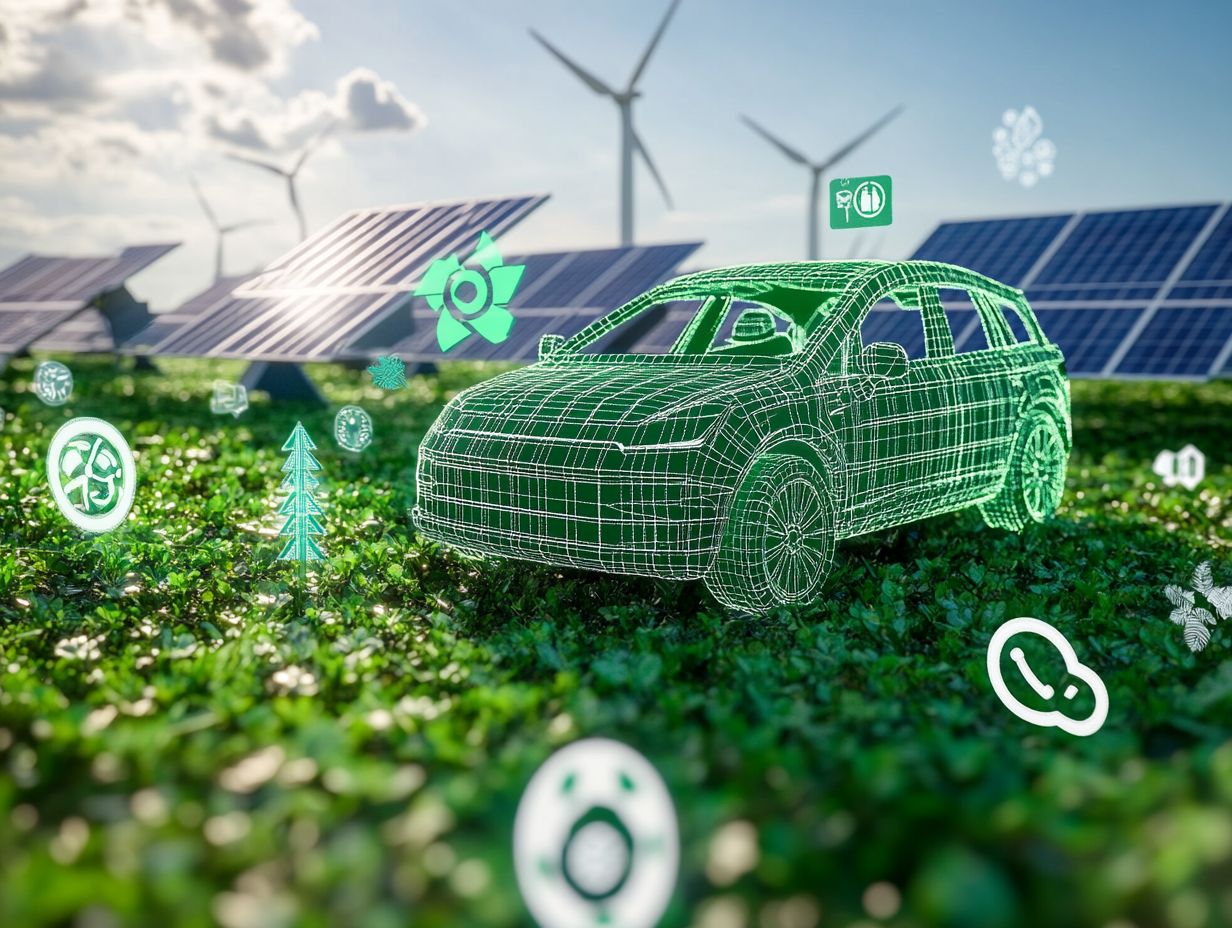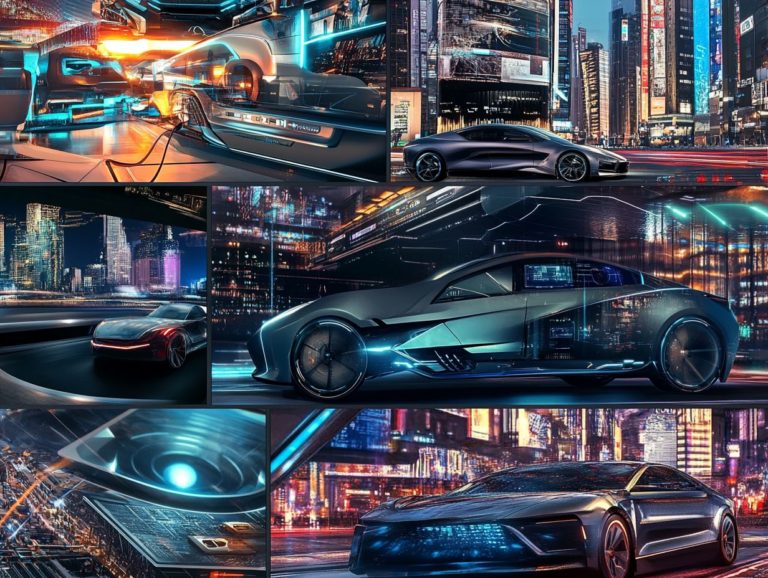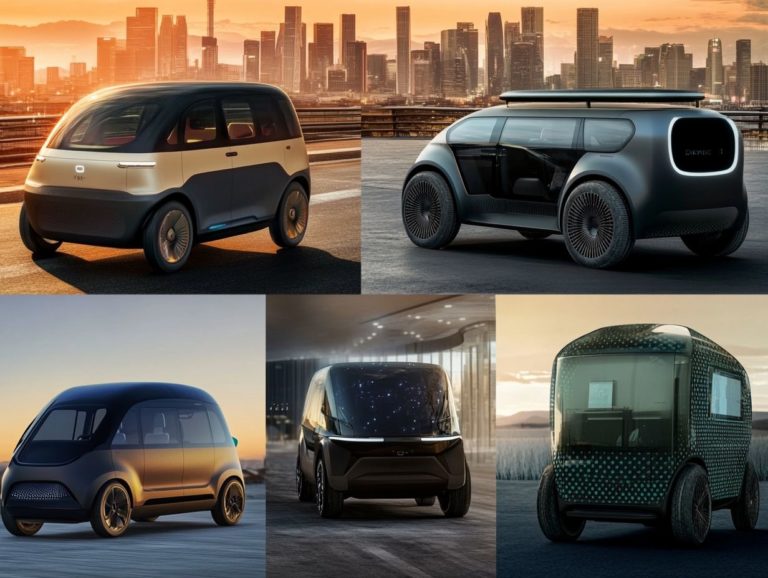5 Key Sustainability Goals for the EV Industry
As the electric vehicle (EV) industry accelerates into the future, you are at a crucial point that can change how we view transportation.
This article delves into five crucial sustainability goals that can elevate EV adoption while nurturing a greener environment. From enhancing battery technology to creating more eco-friendly production processes, each goal is essential in shaping a sustainable automotive landscape.
You will uncover the challenges, benefits, and inspiring examples of companies that are leading the charge toward these vital objectives. Join us now to discover how these initiatives can revolutionize the future of driving!
Contents
- Key Takeaways:
- 1. Why Increase Electric Vehicle Adoption?
- 2. The Importance of Battery Technology
- 3. Reduce the Carbon Footprint of EV Production
- 4. Promote Sustainable Materials and Recycling
- 5. Encourage Collaboration and Innovation in the Industry
- Why Are These Goals Important for the EV Industry?
- What Impact Can Achieving These Goals Have on the Environment?
- How Can Governments and Organizations Support These Goals?
- What Are the Challenges in Achieving These Goals?
- What Are the Potential Benefits for Consumers and Businesses?
- What Are Some Examples of Companies Already Working Towards These Goals?
- Frequently Asked Questions
- What are the 5 key sustainability goals for the EV industry?
- How does the EV industry contribute to reducing carbon emissions?
- What role does renewable energy play in the sustainability goals for the EV industry?
- How does the EV industry aim to increase accessibility of EVs?
- What advancements are being made in EV battery technology to support sustainability goals?
- How does the concept of circular economy tie into the sustainability goals for the EV industry?
Key Takeaways:

- Increasing EV adoption is crucial for reducing carbon emissions and promoting sustainable transportation.
- Improving battery technology and infrastructure will make EVs more efficient and accessible, positively impacting the environment.
- Reducing the carbon footprint of EV production and promoting sustainable materials and recycling will help minimize the industry’s environmental impact.
1. Why Increase Electric Vehicle Adoption?
Increasing electric vehicle adoption is vital for reducing carbon emissions and promoting electric mobility. This shift not only paves the way for a sustainable future but also enhances energy access in communities worldwide, particularly in the Global South, where transportation infrastructure often struggles to keep pace.
To make this change happen, prioritize several key strategies. Enhancing the charging infrastructure is critical, as it directly addresses range anxiety and accessibility, making EVs more attractive to potential buyers.
Offering financial incentives, such as tax rebates and subsidized costs, can significantly encourage adoption. Automotive giants like Tesla, Toyota, Ford, and Mercedes-Benz play a crucial role in this landscape, innovating and expanding their electric vehicle offerings to ensure a diverse market with options across various price points.
This change benefits urban planning by reducing air pollution and optimizing space as charging stations become integrated within communities. It also opens up new markets for sustainable technology. The positive health impacts from lower emissions will elevate the quality of life in densely populated areas, making the case for electric vehicles increasingly compelling.
2. The Importance of Battery Technology
Improving battery technology and infrastructure is vital for your journey in the electric vehicle industry. With advancements in battery management and cutting-edge technologies like lithium-ion, you can significantly enhance the efficiency and sustainability of your electric mobility solutions.
Smart charging solutions are at the forefront of this evolution, allowing you to optimize charging times and energy consumption. This not only benefits you as a vehicle owner but also supports the grid itself. By incorporating bi-directional charging, you can use your vehicle s battery to supply energy back to the grid during peak demand periods, effectively extending its lifecycle.
Integrating energy storage systems with smart grid technologies creates a more resilient charging infrastructure that can balance supply and demand. This ultimately leads to a more sustainable and reliable energy ecosystem, benefiting everyone involved in the process.
3. Reduce the Carbon Footprint of EV Production
To forge a sustainable future, you must prioritize reducing the carbon footprint associated with electric vehicle production. This requires innovative waste management strategies, along with implementing sustainable practices for EV owners.
A commitment to the principles of a circular economy within the automotive sector is essential to minimize environmental impact.
In this context, using renewable energy in your manufacturing is key to cutting emissions. Take inspiration from industry leaders like Hyundai, who are progressively transitioning to solar and wind energy to power their production plants, showcasing a clear dedication to sustainability.
Consider the strong battery recycling strategies implemented by Nissan, which aim to reclaim valuable materials and lessen dependence on newly mined resources. By learning from these initiatives, you can enhance your sustainability credentials and positively contribute to both the environment and global efforts to combat climate change.
4. Promote Sustainable Materials and Recycling

Promoting sustainable materials and effective recycling strategies is essential in the electric vehicle industry. It addresses the environmental risks tied to waste disposal and supports a circular supply chain designed to maximize resource efficiency while minimizing health risks. Adopting the 5 steps to a sustainable EV lifestyle can further enhance these efforts.
By embracing sustainable practices, you can significantly reduce your carbon footprint. This will spark innovation in the use of eco-friendly materials.
The potential of second-life batteries presents an exciting opportunity to repurpose energy storage solutions across various applications, extending their lifespan and reducing landfill impact.
Implementing robust recycling strategies not only helps mitigate environmental harm but also conserves valuable resources. This ensures that the electric vehicle industry can thrive, aligning with the growing importance of EV sustainability without jeopardizing the planet’s future.
This approach aligns seamlessly with global sustainability goals and fosters consumer trust, ultimately driving market growth.
5. Encourage Collaboration and Innovation in the Industry
Encouraging collaboration and innovation in the electric vehicle industry can propel you toward unprecedented advancements in technology and sustainability. This fosters electric vehicle adoption across various markets, ensuring that industry leaders like Ford, Tesla, and Mercedes-Benz remain at the forefront of this transformative shift.
The synergy among automotive manufacturers, governments, and non-governmental organizations is vital in this evolution. Initiatives such as the COP 21 agreements demonstrate how collective efforts can yield significant results in reducing carbon emissions and promoting sustainable transportation.
By setting ambitious emissions reduction targets and supporting research and development, you and your partners can contribute to a greener future.
Partnerships facilitate knowledge sharing and the development of best practices. This ultimately leads to innovative solutions that enhance vehicle performance and improve public infrastructure.
This collaborative framework paves the way for breakthrough technologies while also helping to create robust policies that encourage a broader shift toward eco-friendly transportation solutions.
Why Are These Goals Important for the EV Industry?
These goals are vital for the electric vehicle industry as they strive to reduce carbon emissions and minimize environmental impact while championing electric mobility. Understanding how 5 ways EVs support sustainable development goals is especially critical for fostering sustainable development in the Global South and unlocking market potential in emerging economies.
By prioritizing the transition to electric vehicles, you address significant health risks associated with traditional internal combustion engines, such as air pollution and respiratory diseases. This shift will improve public health and create cleaner urban spaces.
As these objectives come to fruition, you can start saving on fuel costs and enjoy reduced maintenance expenses tied to electric vehicles. Embracing sustainable transportation will lead to a considerable decrease in greenhouse gas emissions, setting the stage for a healthier planet and a more resilient economy for generations to come.
What Impact Can Achieving These Goals Have on the Environment?
Achieving these goals can profoundly lessen the environmental impact of the automotive sector. By lowering carbon emissions, promoting sustainable production practices, and encouraging electric vehicle adoption, you can collectively enhance waste management efforts. Understanding the impact involves evaluating the sustainability of the EV industry.
When you increase the adoption of electric vehicles, you can witness substantial improvements in air quality. For instance, studies have shown that replacing just one million conventional cars with electric alternatives could reduce carbon dioxide emissions by around 8.4 million metric tons each year. This shift reduces our dependence on fossil fuels, which currently fuel over 70% of transportation energy sources.
Look at countries like Norway, where electric vehicles accounted for over 54% of all new car sales in 2020. This shift led to a significant drop in urban air pollution, proving that ambitious environmental goals can translate into real public health benefits.
How Can Governments and Organizations Support These Goals?

Governments and organizations are essential allies in achieving sustainability goals by crafting effective electric vehicle policies, offering enticing incentives for both consumers and manufacturers, and addressing 5 major challenges for electric vehicle manufacturers that align with these objectives.
To increase their effectiveness, governments can introduce subsidies for electric vehicles, making them more accessible and appealing to a wider audience. It s also critical to establish stringent regulations that target emissions from traditional vehicles, driving the necessary shift toward cleaner alternatives.
Investments in a robust charging infrastructure are vital to this transition, ensuring that electric vehicle users have seamless access to charging stations when they need them. Organizations can play a key role in fostering public awareness and engagement by launching educational campaigns, encouraging community involvement, and collaborating with stakeholders to effectively demonstrate the environmental benefits of adopting electric vehicles.
What Are the Challenges in Achieving These Goals?
The goals set for the electric vehicle industry are indeed ambitious, but several challenges demand your attention. You must address the need for improved infrastructure, better battery technology, and effective waste disposal methods to truly support widespread adoption and market expansion of electric vehicles. Additionally, exploring ways to promote sustainability in EV usage can significantly enhance these efforts.
Technological limitations can often hinder manufacturers from fully realizing the potential of these innovative vehicles. Economic barriers, such as high initial costs and a lack of government incentives, further complicate the landscape. Established automotive sectors frequently exhibit a reluctance to embrace change, leading to resistance against the integration of new technologies.
To navigate these challenges, stakeholders should consider collaborating to develop advanced charging networks, investing in research for more efficient battery technologies, and promoting policies that encourage both consumer adoption and a transition toward sustainable practices in the industry.
What Are the Potential Benefits for Consumers and Businesses?
The potential benefits of these goals for you and your business are substantial, presenting opportunities for significant cost savings through reduced fuel expenses, enhanced sustainability practices, and improved health benefits stemming from cleaner air thanks to the widespread adoption of top sustainable electric vehicle brands.
Electric vehicles can drastically lower your operational costs by minimizing maintenance requirements and harnessing more efficient energy sources. For your community, the transition to electric transportation means fewer emissions, leading to better public health outcomes and alleviating pressure on healthcare systems.
As a consumer, you not only benefit from reduced fuel expenditures but also from innovative technologies that elevate your driving experience. The overall value proposition becomes increasingly enticing as more incentives arise, making the shift to electric vehicles even more advantageous for everyone involved.
What Are Some Examples of Companies Already Working Towards These Goals?
Many companies, including Tesla, Ford, Mercedes-Benz, and Toyota, are at the forefront of the movement toward sustainability. They are investing in innovative technologies for electric vehicles and advanced battery management systems.
Take Tesla, for example. They’ve rolled out the Model Y and the Cybertruck, featuring modern electric designs that appeal to many people. Ford isn’t lagging, either; they’ve introduced the Mustang Mach-E and the electrifying F-150 Lightning, both focusing on performance and efficiency.
Mercedes-Benz is also making significant progress. They are boasting impressive advancements in battery life and faster charging that are crucial for the future of driving with their EQ series. Meanwhile, Toyota is actively participating in the electric vehicle revolution, emphasizing its hybrid technology and outlining plans for hydrogen fuel cell vehicles.
These initiatives set the bar for industry standards and shape market trends, compelling competitors to elevate their offerings and adopt eco-friendly solutions.
Watch this video to learn more about sustainability in the EV industry.
Frequently Asked Questions

What are the 5 key sustainability goals for the EV industry?
The 5 key sustainability goals for the EV industry are:
- Reducing carbon emissions
- Promoting renewable energy
- Increasing accessibility of EVs
- Improving battery technology
- Promoting a circular economy
How does the EV industry contribute to reducing carbon emissions?
EVs are powered by electricity, which emits significantly less carbon compared to gasoline and diesel-powered vehicles. This helps to lower carbon emissions and combat climate change.
What role does renewable energy play in the sustainability goals for the EV industry?
Renewable energy sources, such as solar and wind, can power EVs, making them even more environmentally friendly. This reduces reliance on fossil fuels and promotes a cleaner energy ecosystem.
How does the EV industry aim to increase accessibility of EVs?
The EV industry is working to make EVs more affordable and accessible to a wider range of consumers. This includes offering incentives, subsidies, and implementing charging infrastructure to make EV ownership more feasible for everyone.
What advancements are being made in EV battery technology to support sustainability goals?
The EV industry is continuously researching and investing in new battery technology. The aim is to improve the performance and range of EVs while also reducing the environmental impact of battery production and disposal.
How does the concept of circular economy tie into the sustainability goals for the EV industry?
The circular economy approach aims to minimize waste and promote the reuse and recycling of materials. In the EV industry, this means finding ways to recycle batteries and promoting the use of sustainable materials in EV production.






